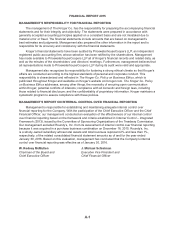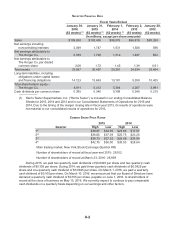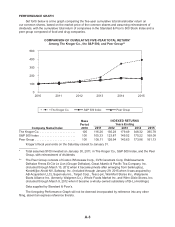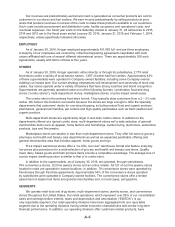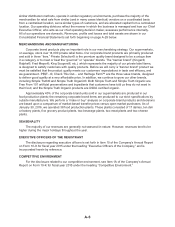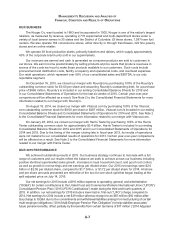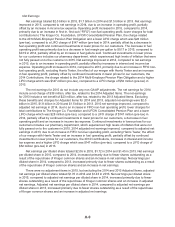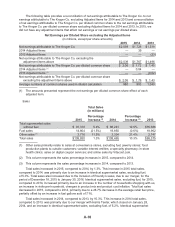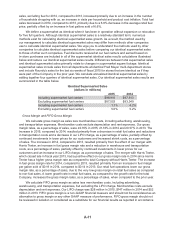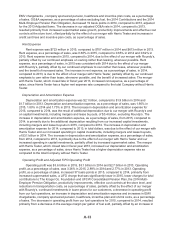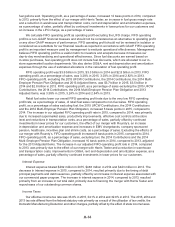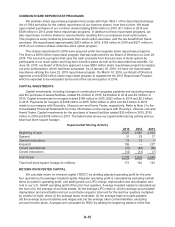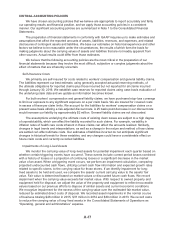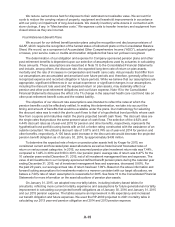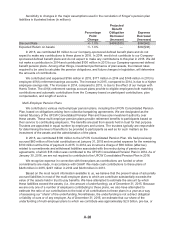Kroger 2015 Annual Report Download - page 85
Download and view the complete annual report
Please find page 85 of the 2015 Kroger annual report below. You can navigate through the pages in the report by either clicking on the pages listed below, or by using the keyword search tool below to find specific information within the annual report.
A-11
sales, excluding fuel for 2014, compared to 2013, increased primarily due to an increase in the number
of households shopping with us, an increase in visits per household and product cost inflation. Total fuel
sales decreased in 2014, compared to 2013, primarily due to a 6.8% decrease in the average retail fuel
price, partially offset by an increase in fuel gallons sold of 6.6%.
We define a supermarket as identical when it has been in operation without expansion or relocation
for five full quarters. Although identical supermarket sales is a relatively standard term, numerous
methods exist for calculating identical supermarket sales growth. As a result, the method used by
our management to calculate identical supermarket sales may differ from methods other companies
use to calculate identical supermarket sales. We urge you to understand the methods used by other
companies to calculate identical supermarket sales before comparing our identical supermarket sales
to those of other such companies. Fuel discounts received at our fuel centers and earned based on
in-store purchases are included in all of the supermarket identical sales results calculations illustrated
below and reduce our identical supermarket sales results. Differences between total supermarket sales
and identical supermarket sales primarily relate to changes in supermarket square footage. Identical
supermarket sales include sales from all departments at identical Fred Meyer multi-department stores
and include Roundy’s sales for the last six weeks of fiscal 2015 for stores that are identical as if they
were part of the Company in the prior year. We calculate annualized identical supermarket sales by
adding together four quarters of identical supermarket sales. Our identical supermarket sales results are
summarized in the table below.
Identical Supermarket Sales
(dollars in millions)
2015 2014
Including supermarket fuel centers $98,916 $97,813
Excluding supermarket fuel centers $87,553 $83,349
Including supermarket fuel centers 1.1% 4.2%
Excluding supermarket fuel centers 5.0% 5.2%
Gross Margin and FIFO Gross Margin
We calculate gross margin as sales less merchandise costs, including advertising, warehousing,
and transportation expenses. Merchandise costs exclude depreciation and rent expenses. Our gross
margin rates, as a percentage of sales, were 22.16% in 2015, 21.16% in 2014 and 20.57% in 2013. The
increase in 2015, compared to 2014, resulted primarily from a decrease in retail fuel sales and reductions
in transportation costs and a decrease in our LIFO charge, as a percentage of sales, partially offset by
continued investments in lower prices for our customers and increased shrink costs, as a percentage
of sales. The increase in 2014, compared to 2013, resulted primarily from the effect of our merger with
Harris Teeter, an increase in fuel gross margin rate and a reduction in warehouse and transportation
costs, as a percentage of sales, partially offset by continued investments in lower prices for our
customers and an increase in our LIFO charge, as a percentage of sales. The merger with Harris Teeter,
which closed late in fiscal year 2013, had a positive effect on our gross margin rate in 2014 since Harris
Teeter has a higher gross margin rate as compared to total Company without Harris Teeter. The increase
in fuel gross margin rate for 2014, compared to 2013, resulted primarily from an increase in fuel margin
per gallon sold of $0.19 in 2014, compared to $0.14 in 2013. Our retail fuel operations lower our gross
margin rate, as a percentage of sales, due to the very low gross margin on retail fuel sales as compared
to non-fuel sales. A lower growth rate in retail fuel sales, as compared to the growth rate for the total
Company, increases the gross margin rates, as a percentage of sales, when compared to the prior year.
We calculate FIFO gross margin as sales less merchandise costs, including advertising,
warehousing, and transportation expenses, but excluding the LIFO charge. Merchandise costs exclude
depreciation and rent expenses. Our LIFO charge was $28 million in 2015, $147 million in 2014 and $52
million in 2013. FIFO gross margin is a non-GAAP financial measure and should not be considered as an
alternative to gross margin or any other GAAP measure of performance. FIFO gross margin should not
be reviewed in isolation or considered as a substitute for our financial results as reported in accordance


